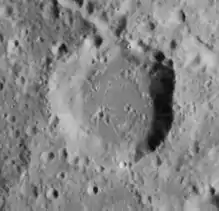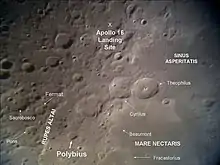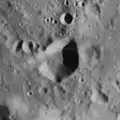Polybius (crater)
Polybius is a lunar impact crater in the southeast part of the Moon, and is named after ancient Greek historian Polybius.[1] It is located to the south-southeast of the larger crater Catharina, in the area framed by the Rupes Altai scarp. Some distance to the northeast is the Mare Nectaris, with the flooded craters Beaumont and Fracastorius.
 Lunar Orbiter 4 image | |
| Coordinates | 22.4°S 25.6°E |
|---|---|
| Diameter | 41 km |
| Depth | 2.1 km |
| Colongitude | 335° at sunrise |
| Eponym | Polybius |

The crater rim of Polybius appears slightly distended in the northeast, and has a cut through the northern wall. But the wall is otherwise moderately intact with only minor erosion. The interior floor is flat and almost featureless, with no central rise. To the south and east, a ray from Tycho cuts across the bowl-shaped Polybius A and Polybius B craterlets.
Satellite craters

By convention these features are identified on lunar maps by placing the letter on the side of the crater midpoint that is closest to Polybius.
| Polybius | Latitude | Longitude | Diameter |
|---|---|---|---|
| A | 23.0° S | 28.0° E | 17 km |
| B | 25.5° S | 25.5° E | 12 km |
| C | 22.0° S | 23.6° E | 29 km |
| D | 26.9° S | 27.9° E | 9 km |
| E | 24.4° S | 26.2° E | 9 km |
| F | 22.2° S | 23.0° E | 21 km |
| G | 22.5° S | 22.7° E | 5 km |
| H | 21.1° S | 22.7° E | 8 km |
| J | 22.7° S | 23.5° E | 9 km |
| K | 24.3° S | 25.3° E | 14 km |
| L | 22.0° S | 28.2° E | 7 km |
| M | 21.3° S | 22.1° E | 6 km |
| N | 23.4° S | 26.8° E | 13 km |
| P | 21.5° S | 22.9° E | 17 km |
| Q | 25.1° S | 27.5° E | 6 km |
| R | 25.6° S | 27.3° E | 7 km |
| T | 26.1° S | 25.5° E | 12 km |
| V | 25.2° S | 29.1° E | 6 km |
Polybius K is sometimes referred to as "Larrieu’s Dam" because the unusually straight northwest rim of the crater creates the appearance of a dam under certain lighting conditions.[2]
 Polybius K crater
Polybius K crater
References
- "Gazetteer of Planetary Nomenclature | Polybius". usgs.gov. International Astronomical Union. Retrieved August 24, 2017.
- ‘Larrieu’s Dam’; the ‘rediscovery’ of a seldom explored topographical lunar feature in the foothills of the Rupes Altai. Nigel Longshaw. J. Br. Astron. Assoc. 118, 2, 2008.
- Andersson, L. E.; Whitaker, E. A. (1982). NASA Catalogue of Lunar Nomenclature. NASA RP-1097.
- Bussey, B.; Spudis, P. (2004). The Clementine Atlas of the Moon. New York: Cambridge University Press. ISBN 978-0-521-81528-4.
- Cocks, Elijah E.; Cocks, Josiah C. (1995). Who's Who on the Moon: A Biographical Dictionary of Lunar Nomenclature. Tudor Publishers. ISBN 978-0-936389-27-1.
- McDowell, Jonathan (July 15, 2007). "Lunar Nomenclature". Jonathan's Space Report. Retrieved 2007-10-24.
- Menzel, D. H.; Minnaert, M.; Levin, B.; Dollfus, A.; Bell, B. (1971). "Report on Lunar Nomenclature by the Working Group of Commission 17 of the IAU". Space Science Reviews. 12 (2): 136–186. Bibcode:1971SSRv...12..136M. doi:10.1007/BF00171763.
- Moore, Patrick (2001). On the Moon. Sterling Publishing Co. ISBN 978-0-304-35469-6.
- Price, Fred W. (1988). The Moon Observer's Handbook. Cambridge University Press. ISBN 978-0-521-33500-3.
- Rükl, Antonín (1990). Atlas of the Moon. Kalmbach Books. ISBN 978-0-913135-17-4.
- Webb, Rev. T. W. (1962). Celestial Objects for Common Telescopes (6th revised ed.). Dover. ISBN 978-0-486-20917-3.
- Whitaker, Ewen A. (1999). Mapping and Naming the Moon. Cambridge University Press. ISBN 978-0-521-62248-6.
- Wlasuk, Peter T. (2000). Observing the Moon. Springer. ISBN 978-1-85233-193-1.
| Wikimedia Commons has media related to Polybius (crater). |